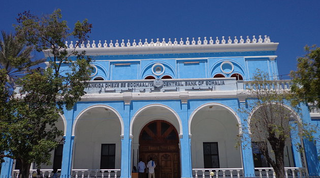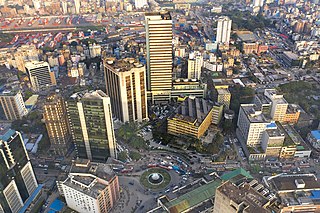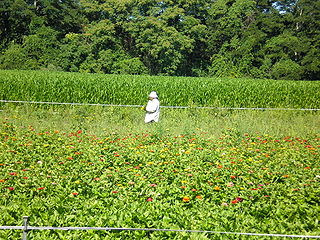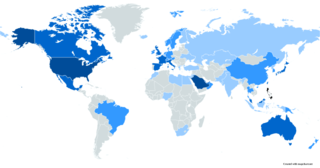Related Research Articles

The economy of Eritrea has undergone extreme changes after the War of Independence. It experienced considerable growth in recent years, indicated by an improvement in gross domestic product in 2011 of 8.7 percent and in 2012 of 7.5% over 2011, and has a total of $8.090 billion as of 2020. However, worker remittances from abroad are estimated to account for 32 percent of gross domestic product.
Hawala or hewala, originating in India as havala, also known as havaleh in Persian, and xawala or xawilaad in Somali, is a popular and informal value transfer system based on the performance and honour of a huge network of money brokers. They operate outside of, or parallel to, traditional banking, financial channels and remittance systems. The system requires a minimum of two hawaladars that take care of the "transaction" without the movement of cash or telegraphic transfer. While hawaladars are spread throughout the world, they are primarily located in the Middle East, North Africa, the Horn of Africa and the Indian subcontinent. Hawala follows Islamic traditions but its use is not limited to Muslims.

The economy of Moldova is an emerging upper-middle income economy, with a high Human Development Index. Moldova is a landlocked Eastern European country, bordered by Ukraine on the East and Romania to the West. It is a former Soviet republic and today a candidate member to the European Union.

The economy of Pakistan is categorized as a developing economy. It ranks as the 24th-largest based on GDP using purchasing power parity (PPP) and the 46th largest in terms of nominal GDP. With a population of 241.5 million people as of 2023, Pakistan’s position at per capita income ranks 161st by GDP (nominal) and 138th by GDP (PPP) according to the International Monetary Fund (IMF).

Somalia is classified by the United Nations as a least developed country, with the majority of its population being dependent on agriculture and livestock for their livelihood. The economy of Somalia is $4.918 billion by gross domestic product as of 2020. For 1994, the CIA estimated it at purchasing power parity to be approximately $3.3 billion. In 2001, it was estimated to be $4.1 billion. By 2009, the CIA estimated that it had grown to $5.731 billion, with a projected real growth rate of 2.6%. In 2014, the International Monetary Fund estimated economic activity to have expanded by 3.7% primarily. This expansion was driven by growth in the primary sector and the secondary sector. According to a 2007 British Chambers of Commerce report, the private sector has experienced growth, particularly in the service sector. Unlike the pre-civil war period, when most services and the industrial sector were government-run, there has been substantial, albeit unmeasured, private investment in commercial activities. The investment has been largely financed by the Somali diaspora, and includes trade and marketing, money transfer services, transportation, communications, fishery equipment, airlines, telecommunications, education, health, construction and hotels.

The economy of Bangladesh is a major developing market economy. As the second-largest economy in South Asia, Bangladesh's economy is the 35th largest in the world in nominal terms, and 25th largest by purchasing power parity. Bangladesh is seen by various financial institutions as one of the Next Eleven. It has been transitioning from being a frontier market into an emerging market. Bangladesh is a member of the South Asian Free Trade Area and the World Trade Organization. In fiscal year 2021–2022, Bangladesh registered a GDP growth rate of 7.2% after the global pandemic. Bangladesh is one of the fastest growing economies in the world.

Human migration is the movement of people from one place to another with intentions of settling, permanently or temporarily, at a new location.

Foreign workers or guest workers are people who work in a country other than one of which they are a citizen. Some foreign workers use a guest worker program in a country with more preferred job prospects than in their home country. Guest workers are often either sent or invited to work outside their home country or have acquired a job before leaving their home country, whereas migrant workers often leave their home country without a specific job in prospect.

A hundi or hundee is a financial instrument that was developed in Medieval India for use in trade and credit transactions. Hundis are used as a form of remittance instrument to transfer money from place to place, as a form of credit instrument or IOU to borrow money and as a bill of exchange in trade transactions. The Reserve Bank of India describes the hundi as "an unconditional order in writing made by a person directing another to pay a certain sum of money to a person named in the order."

India Post is an Indian government-operated postal system in India, and is the trade name of the Department of Post under the Ministry of Communications. Generally known as the Post Office, it is the most widely distributed postal system in the world. Warren Hastings had taken initiative under East India Company to start the Postal Service in the country in 1766. It was initially established under the name "Company Mail". It was later modified into a service under the Crown in 1854 by Lord Dalhousie. Dalhousie introduced uniform postage rates and helped to pass the India Post Office Act 1854 which significantly improved upon 1837 Post Office act which had introduced regular post offices in India. It created the position Director General of Post for the whole country.

An Overseas Filipino is a person of full or partial Filipino origin who trace their ancestry back to the Philippines but are living and working outside of the country. They get jobs in countries and they move to live in countries that they get jobs in. This term generally applies to both people of Filipino ancestry and citizens abroad. As of 2019, there were over 12 million Filipinos overseas.

A remittance is a non-commercial transfer of money by a foreign worker, a member of a diaspora community, or a citizen with familial ties abroad, for household income in their home country or homeland. Money sent home by migrants competes with international aid as one of the largest financial inflows to developing countries. Workers' remittances are a significant part of international capital flows, especially with regard to labor-exporting countries.

The Economy of Somaliland largely relies on primary production and agriculture, where livestock is the main export of the country, which it ships to neighbouring Djibouti and Ethiopia, as well as to Gulf states, such as UAE, Saudi Arabia and Oman. Somaliland has a GDP per capita of $853 and a gross domestic product GDP of $2,583,000,000 as of 2024, most of which it receives in remittances from Somalis working abroad. The COVID-19 pandemic has restricted Somaliland's trade flows with decreased demand in the agriculture sector, a significant source of tax revenue.

Overseas Pakistanis, or the Pakistani diaspora, refers to Pakistanis who live outside of Pakistan. These include citizens that have migrated to another country as well as people born abroad of Pakistani descent. According to the Ministry of Overseas Pakistanis and Human Resource Development, approximately 8.8 million Pakistanis live abroad according to December 2017 estimates. According to the Ministry of Emigration and Overseas Employment, data released in 2023 states that more than 10.80 million people have moved abroad since 1990. beoe.gov.pk
Bangladeshis in Japan form one of the smaller populations of foreigners in Japan. As of in December 2023, Japan's Ministry of Justice recorded 27,962 Bangladeshi nationals among the total population of registered foreigners in Japan.
Remittances to India are money transfers from non-resident Indians (NRIs) employed outside the country to family, friends or relatives residing in India. India is the world's top receiver of remittances, claiming more than 12% of the world's remittances in 2015. Remittances to India stood at US$110 billion in 2022, US$125 billion in 2023 and remittances from India to other countries totalled US$5.710 billion, for a net inflow of US$63.258 billion in 2017.

The Bangladeshi diaspora are people of Bangladeshi birth, descent or origin who live outside of Bangladesh. First-generation migrants may have moved abroad from Bangladesh for various reasons including better living conditions, to escape poverty, to support their financial condition, or to send money back to families there. The Ministry of Expatriates' Welfare and Overseas Employment estimates there are almost 7.5 million Bangladeshis living abroad, the fourth highest among the top 176 countries of origin for international migrants. Annual remittances transferred to Bangladesh were almost $23 billion in 2023, the seventh highest in the world and the third highest in South Asia.
There are hundreds of thousands of Indians in Bangladesh. Citing the results of a survey, a column in The Financial Express claims that as many as 500,000 - 1,000,000 Indians were staying illegally in Bangladesh in 2022. The article claims that they were found working in different establishments such as NGOs, garments, textile, IT and sent money back home through hundi transfer systems.
WorldRemit is a digital cross border remittance business that provides international money transfer and remittance services in more than 130 countries and over 70 currencies. It was founded in 2010 by Ismail Ahmed, Catherine Wines, and Richard Igoe.
International money transfers made by migrant workers and immigrants sending a portion of their earnings to their families in their country of origin are known as remittances. Remittances are an important aspect of the global economy, totaling an estimated $601 billion (USD) for the year 2015. The United States is currently the largest source of international remittances in the world, sending a total of $148 billion in 2017. Mexico received the largest portion of these remittances, accounting for more than $30 billion USD. making the U.S.-Mexico remittance corridor one of the largest in the world. With the exception of the 2008 global financial crisis, remittances sent from the U.S. have been consistently climbing for the past half century. This major increase in remittances can be partially attributed to the larger population of immigrants and migrant workers, as well as to increasing globalization in the financial and money markets. China and India are also major recipients of U.S. remittances, and are the top two recipients of remittances globally.
References
- ↑ "Bangladesh 7th highest remittance recipient: World Bank". The Daily Star . 2022-05-13. Retrieved 2022-06-12.
- ↑ "Bangladesh's remittance inflow hits record high in 2021". New Age. 2022-01-02. Retrieved 2022-06-12.
- ↑ "Utilisation of Workers' Remittances in Bangladesh" (PDF). Bangladesh Bank. Research Department Bangladesh Bank. November 2017. Retrieved August 6, 2020.
- ↑ "Overview". World Bank. Retrieved 2023-08-19.
- 1 2 3 Bangladesh Economic Update: Remittance, 8 September 2011, Unnayan Onneshan, Dhaka, p. 9.
- ↑ "From transit passenger to business tycoon". Khaleej Times. Retrieved 30 March 2017.
- ↑ "Country-wise Inward Remittances". Bangladesh Bank. Retrieved 2019-09-27.
- ↑ "2016 Statistical Yearbook" (PDF). Bangladesh Bureau of Statistics. May 2017. p. 110. Retrieved 2019-10-05.
- ↑ "Yearly data of Wage earner's remittance". Bangladesh Bank. January 2024. Retrieved January 8, 2024.